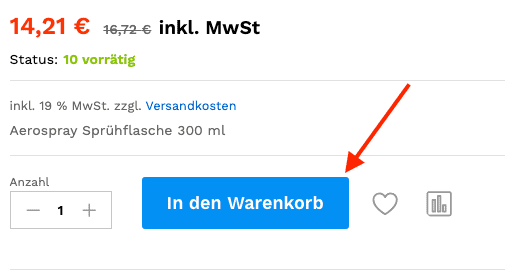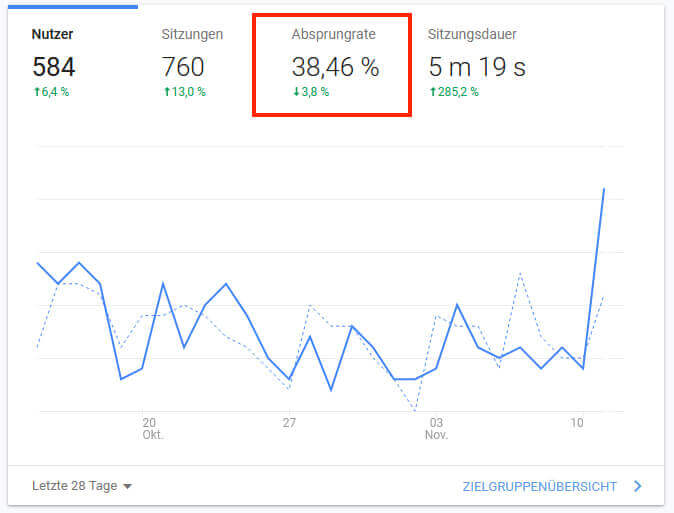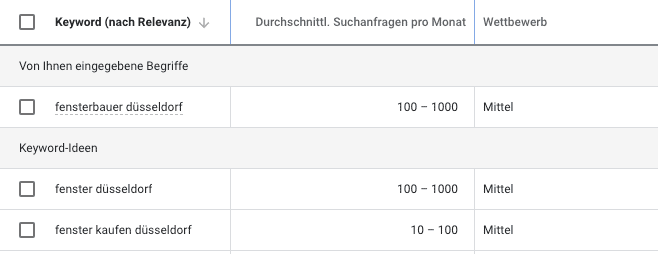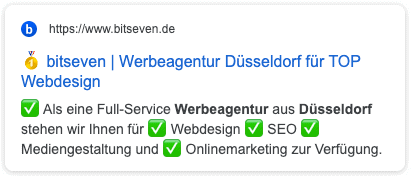The bounce rate is very important for the analysis of your website. The bounce rate is the number of visitors who leave your website - or one of your subpages - after a few seconds. As a website owner you should know the bounce rate of your most important subpages. This is the only way to determine the success of your content. As a rule, the bounce rate should be kept as low as possible. By the way, the bounce rate is a strong ranking factor for Google. One more reason to deal with it. In the following, I would like to explain the bounce rate to you in more detail.
Bounce Rate Definition and Calculation
The definition of the bounce rate is relatively easy to understand compared to other web analytics concepts: A "bounce" describes a session of a visitor in which he only visits a single (sub-)site and then leaves your website again. In this scenario, the entry page is also the exit page.
The bounce rate is calculated from all sessions in which only one site was visited without any further action (e.g. leaving a comment or clicking on a subpage). (e.g. leaving a comment or clicking on a subpage) divided by the total number of sessions.
The analysis of the bounce rate therefore gives you a lot of insights into the performance of your website. Because: The bounce rate tells you how your visitors behave on your website and how well they are integrated. Basically, the leaving of site plays the fundamental role here.
Example calculation and other factors of the bounce rate
Example: For example, if 40 visitors leave a landing page of your website without performing any further interaction on site and a total of 100 visitors were counted, the bounce rate is 40%.
Additional factors: Event hits
A visitor may not open a new subpage, but he may add an item to the shopping cart or share a site via a button on Facebook. These interactions are also recorded and minimize the bounce rate.
Three factors are important here:
Event hits: The user clicks on a button.
E-commerce transaction hits: An item was purchased or added to the shopping cart.
Social-Plugin-Hits: A site is shared via social networks.

Bounce rate vs. exit rate
Bounce rate and exit rate are often considered synonyms, or at least considered to ultimately provide the same data. This is a big misconception and can lead to incorrect bounce rate analysis and poor decisions.
At first glance, both concepts measure similar things, as they analyze the behavior of visitors when they leave the website. Nevertheless, there is an important difference in the calculation:
As described earlier, the bounce rate measures the percentage of visitors who access (enter) a website and leave it again before interacting with it in any way. The exit rate, on the other hand, describes the percentage of visitors who left the website after viewing a particular site - regardless of how many subpages of the website they visited earlier in the session.
Example: A visitor lands on your homepage and clicks "About us" (good for the bounce rate of the homepage, because another action was taken). However, the visitor only stays on the "About us"site for 3 seconds and then closes the site (bad for the exit rate of the "About us"site ).
Average bounce rates

The question of which bounce rate values describe a low, high or average bounce rate is difficult to answer. Because what represents a high bounce rate for some may be considered low by others. Last but not least, the purpose of the subpage, the design or the industry must always be considered when evaluating the bounce rate.
In rare cases, a high bounce rate is actually beneficial. For example, leaving a blog article could indicate that all questions have been answered by the reader and there is no need for further research.
As a rule, the bounce rate gives you an indication of how relevant and "captivating" your website visitors find the content of your website. However, you should not rely on this value alone when analyzing your website. Because in order to evaluate the success and performance of your website, you should always include several factors such as page views, dwell time, interaction and loading speed. This way you will get a comprehensive impression of the visitor behavior.
What is a good bounce rate?
Industry standard bounce rates consider anything over 50 percent to be high and anything between 20 and 50 percent to be low. Anything below 20 percent is probably a mistake and should be investigated.
A good bounce rate should be between 20 and 50 percent of total visits. However, it's important that you consider other measurement tools and analysis techniques to get a comprehensive insight into the behavior of your website visitors. Because as mentioned above, you can't give a blanket guideline here.
How to check the bounce rate of your website
Now that you know what the bounce rate actually means, I'll explain in the next step where you can read this value. To do this, you need to look at the Google Analytics data of your website. In addition to the bounce rate, Google Analytics also provides other exciting metrics that help you interpret user behavior. Unfortunately, it would go beyond the scope of this article to go into these in detail.
How to set up Google Analytics in WordPress is explained by Jonas Tietgen from WP Ninjas in this tutorial.
First, log in to Google Analytics. Select the "Audience Overview" tab there. Here you will also find many other metrics that can be very useful. This is where all your bounce rate information is listed. You can see here how high your homepage bounce rate is and how your subpages and other links are performing. This will give you a better and clearer insight. For the entire website, simply click on the bounce rate metric, which also includes a graph for the defined time period.

Click Behavior for individual pages, and then click All Pages. A list of pages and links on the site and the specific bounce rate will be displayed.
6 Ways to Improve Your Bounce Rate:
Once you understand the concept of bounce rate, your next question is probably, "Why is my website's bounce rate so high?" and more importantly, "How can I effectively lower my bounce rate?" Below, I'll show you six starting points to optimize your bounce rate.
#1: Optimize the content of your (sub-)sites
One of the easiest ways to reduce the bounce rate of one site or even the whole website is to improve the content itself. In some ways, this should be self-explanatory. The more interesting or better written the content is, the more likely the visitor will stay on your site and find out what else it has to offer. If it's eCommerce, it can also create trust, strengthen the brand or stimulate further sales.
Of course, the relevance of your content is also important. Topics that do not correspond to the target group of your website are likely to meet with disinterest and lead to an increase in the bounce rate.
Tip: Hire a copywriter for your web content. This is a one-time expense that pays for itself very quickly. Get references from the copywriter beforehand. Does his writing style make you want to buy? If so, go for it!
#2: Pay attention to good legibility and structure
Content refers not only to interesting articles or entertaining media, but also to the readability of the written texts. Text-intensive websites may be filled with the most relevant information - but if the site is not structured in an appealing way, the first impression already fails.
Make sure you use a mix of images, bulleted lists, subheadings and quotes. After all, if the content is presented in an engaging way and provides your readers with the value they're looking for, they're more likely to be interested in more of your content and not bounce.
If you want your visitors to take a certain action, you should place appropriate calls to action. For example, you can include a form with the call-to-action "If you want to receive more information about this topic, sign up for our newsletter". This will also reduce your bounce rate.
#3: Avoid the use of pop-ups
By using intrusive pop-ups, you distract your visitor from reading and compromise the user experience. Thus, you should only use them selectively and above all make sure that the content of the pop-up is relevant to the reader at that moment.
Pop-ups can help to build a subscriber list with a certain degree of effectiveness. Nevertheless, there are more effective measures that are far less intrusive. For example, cleverly placed ad banners to which visitors can react as soon as they have the opportunity to deal with the content.
Tip: The only exception to this is the "Exit Pop-ups". These are the pop-ups that appear when you want to leave site . Sure, this might annoy your visitor - but they were about to leave your site anyway. So why not take your last chance?
#4: Use targeted keywords (SEO)
Reducing bounce rate always requires a mix of tactics. One of the most reliable is the targeted use of keywords. The key is relevance, not including as many keywords as possible.
The best starting point is to use keywords with high traffic value. But how can you find out which keywords are relevant to your website? Well, it's not as complex as you might think. For example, a useful tool to identify targeted keywords for your website is Google Keyword Planner. The tool is free, you just need a Google account.

A detailed guide on how to perform a keyword research gives you Dominik Stein in this article.
Use two to three relevant keywords on your website. Repeat them a few times. However, don't forget that you are writing for humans and not for machines. So please avoid sentences like the following:
"08/15 Fensterbau Dortmund GmbH - best window construction Dortmund, if you need windows Dortmund 08/15 Fensterbau Dortmund is optimal for windows Dortmund seekers. Windows Dortmund."
#5: Check your meta descriptions
Meta descriptions are the information that appears directly below the title description of a website in a Google search. When your site appears in Google search results, many of your potential website visitors will read your meta description first. With the bounce rate in mind, it's important not to lure your visitors with false promises.

If your meta description says "refrigerators for 30 euros", although no item in your refrigerator shop costs less than 100 euros, visitors will leave your shop disappointed without interacting further with your website. The consequence: your bounce rate increases.
#6: Include videos on your website
A video on a landing page increases the conversion rate by up to 80%. Of course, this also has a positive effect on the bounce rate. A short explainer video will be more than enough. If an animated video doesn't fit your budget (yet) and you don't like to stand in front of the camera yourself, a recording of your screen and an audio track of you explaining it is often enough. To get a decent sound quality, you should use a good microphone.
Conclusion
A low bounce rate is a good indication that visitors are interacting with your website and that you are providing them with relevant content. With the tips and tricks from this article, you can not only find out what your current bounce rate is. I also want to give you practical measures on how to improve your bounce rate. With this in mind: Good luck optimizing your website!
